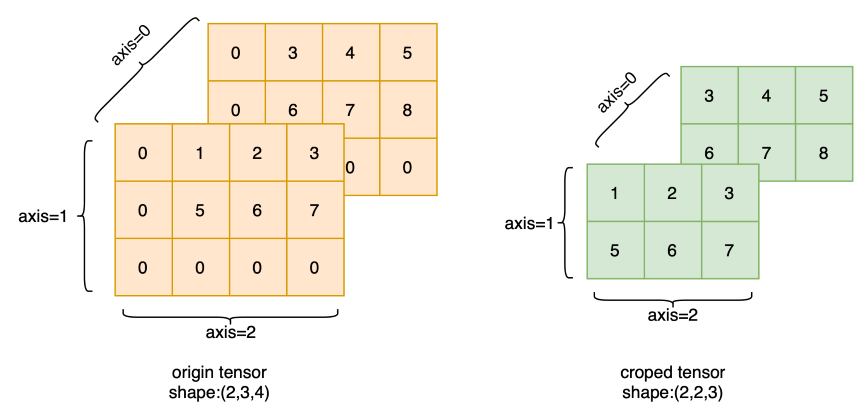crop
- paddle. crop ( x: Tensor, shape: ShapeLike | None = None, offsets: Sequence[int] | Tensor | None = None, name: str | None = None ) Tensor [source]
-
Crop input into output, as specified by offsets and shape.
* Case 1 (input is a 2-D Tensor): Input: X.shape = [3, 5] X.data = [[0, 1, 2, 0, 0], [0, 3, 4, 0, 0], [0, 0, 0, 0, 0]] Parameters: shape = [2, 2] offsets = [0, 1] Output: Out.shape = [2, 2] Out.data = [[1, 2], [3, 4]] * Case 2 (input is a 3-D Tensor): Input: X.shape = [2, 3, 4] X.data = [[[0, 1, 2, 3], [0, 5, 6, 7], [0, 0, 0, 0]], [[0, 3, 4, 5], [0, 6, 7, 8], [0, 0, 0, 0]]] Parameters: shape = [2, 2, -1] offsets = [0, 0, 1] Output: Out.shape = [2, 2, 3] Out.data = [[[1, 2, 3], [5, 6, 7]], [[3, 4, 5], [6, 7, 8]]]The image below demonstrates the Case 2 that a 3D tensor with shape [2,3,4] is cropped into a 3D tensor with shape [2,2,3]

- Parameters
-
x (Tensor) – 1-D to 6-D Tensor, the data type is float32, float64, int32 or int64.
shape (list|tuple|Tensor, optional) – The output shape is specified by shape. Its data type is int32. If a list/tuple, it’s length must be the same as the dimension size of x. If a Tensor, it should be a 1-D Tensor. When it is a list, each element can be an integer or a Tensor of shape: [1]. If Variable contained, it is suitable for the case that the shape may be changed each iteration.
offsets (list|tuple|Tensor, optional) – Specifies the cropping offsets at each dimension. Its data type is int32. If a list/tuple, it’s length must be the same as the dimension size of x. If a Tensor, it should be a 1-D Tensor. When it is a list, each element can be an integer or a Tensor of shape: [1]. If Variable contained, it is suitable for the case that the offsets may be changed each iteration. Default: None, the offsets are 0 at each dimension.
name (str|None, optional) – Name for the operation (optional, default is None). For more information, please refer to api_guide_Name.
- Returns
-
Tensor, The cropped Tensor has same data type with x.
Examples
>>> import paddle >>> x = paddle.to_tensor([[1, 2, 3], [4, 5, 6], [7, 8, 9]]) >>> # x.shape = [3, 3] >>> # x = [[1, 2, 3], [4, 5, 6], [7, 8, 9]] >>> # shape can be a 1-D Tensor or list or tuple. >>> shape = paddle.to_tensor([2, 2], dtype='int32') >>> # shape = [2, 2] >>> # shape = (2, 2) >>> out = paddle.crop(x, shape) >>> # out.shape = [2, 2] >>> # out = [[1,2], [4,5]] >>> # offsets can be a 1-D Tensor or list or tuple. >>> offsets = paddle.to_tensor([0, 1], dtype='int32') >>> # offsets = [1, 0] >>> # offsets = (1, 1) >>> out = paddle.crop(x, shape, offsets) >>> # out.shape = [2, 2] >>> # if offsets = [0, 0], out = [[1,2], [4,5]] >>> # if offsets = [0, 1], out = [[2,3], [5,6]] >>> # if offsets = [1, 0], out = [[4,5], [7,8]] >>> # if offsets = [1, 1], out = [[5,6], [8,9]]
